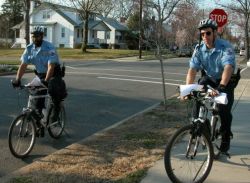 Story and photos by Jan Myers (all rights are reserved by author)
Story and photos by Jan Myers (all rights are reserved by author)
You hear about it in the news all the time: “Farmer reportsequipment stolen sometime overnight.” “Meth lab discovered in abandoned shed.” “Fertilizer stolen from farm.” “Copper stolen from rural church.” “Sadly, the crime in rural areas isn’t just tipping cows anymore,” said Robbi Woodson, National Sheriffs’ Association Manager for the National Neighborhood Watch Program. The theft of crops, timber, chemicals, livestock and expensive equipment is a growing concern for farm owners. Vandals not only break or blow up mailboxes, but they also destroy crops and steal common farming chemicals, turning them into lethal and illegal materials. “With the present economic conditions, attacks on farm property are becoming more frequent,” said Dick Green, an instructor with the Ohio Crime Prevention Association (OCPA) and CEO of Covered Bridge Productions, Inc., a security consulting company in Eaton in Preble County. “The remoteness from other neighbors, lax security and the distance law enforcement must travel to the area all are factors.” Coshocton County Sheriff Tim Rogers, second vice president of the Buckeye State Sheriffs’ Association and a recent graduate of the FBI National Academy, agrees. “Thefts and drugs continue to be an everyday challenge in our region,” he stressed. “These two areas of crime are most likely due to our depressed local economy and the criminals’ attempts to support their drug habits. The current high price of scrap metal also has been a strong influence, with many recent thefts from our farming community even taking place in daytime hours.” Scrap metal theft One of the biggest issues in rural areas is the theft of scrap metal.
 “If I go back to patrol, there's no more Neighborhood Watches. That's it. We're the only ones trained for that. If anything, with the economy the way it is, we need more eyes and ears out there, and not less,” said Officer Diane Tillery, the community services officer for the 6th District. Tillery has organized Neighborhood Watch programs in Montgomery Village , Md. . (“ Budget cuts hit public safety programs; Neighborhood Watch, Latino outreach among the programs that will suffer, officials say,” by C. Benjamin Ford | staff writer, www.gazette.net/stories/031908/montnew11819_32357.shtml)
“If I go back to patrol, there's no more Neighborhood Watches. That's it. We're the only ones trained for that. If anything, with the economy the way it is, we need more eyes and ears out there, and not less,” said Officer Diane Tillery, the community services officer for the 6th District. Tillery has organized Neighborhood Watch programs in Montgomery Village , Md. . (“ Budget cuts hit public safety programs; Neighborhood Watch, Latino outreach among the programs that will suffer, officials say,” by C. Benjamin Ford | staff writer, www.gazette.net/stories/031908/montnew11819_32357.shtml)
Montgomery County is not the only jurisdiction considering such budget cuts. Throughout the country, officers are talking about the decreases in community policing positions in their own departments and the increased concern from local communities. Law enforcement executives are in a difficult catch-22 position: They are forced to propose cuts to public safety that will have a definite impact on their communities, and community members are demanding more services as crime and quality-of-life issues are on the rise.
Whether economic-related or simply the current trend, increases in crime require more than just additional officers on patrol to answer calls for service. Real crime issues are addressed most efficiently when the community and the police work as partners. When there are too few officers to go around, it is even more critical for law enforcement executives to place a strong emphasis on programs such as Neighborhood Watch. Education is the key to helping community members be better prepared to address crime concerns, and to better report real crimes, leading to a decrease in calls for service, and more resources can be provided to communities to address other concerns.
Whether officers work in assignments with a specific community policing agenda or work the street responding to calls, successful crime prevention efforts involve developing close ties to the community being served. Law enforcement leaders should not lose sight of the fact that community-based programs make an officer's job easier because community trust is increased and intelligence is more forthcoming in those environments. Better intelligence leads to better closure rates of crime, which in turn has the potential for reducing the overall incidence of crime in a particular area. “Neighborhood Watch presents an opportunity to get volunteers to work together to identify problems and build partnerships with law enforcement.” said Retired Sheriff Aaron Kennard and current Executive Director of the National Sheriffs' Association
Executive-level support of line officers working in the community does much to enhance morale of officers already spread too thin. Officer buy-in goes far in strengthening bonds between law enforcement and the community and in making community members more responsive in addressing their own crime concerns. Chief Matthew Boyd of the Miami Gardens Police Department believes that “as a police chief, I've discovered by taking a personal interest in crime prevention programs, that resonates to the subordinates who tend to enhance their skills and provide product that is more representative of the chief and the department.”
 Relationship-building programs are only as successful as their inputs. Law enforcement must recognize that community demand will increase as long as the security of a neighborhood is threatened. An educated community that is better prepared to address these challenges will significantly impact overall calls for service and ultimately the time demands of officers. Despite budget issues, police managers at the executive level must strive to support the efforts of the officers working in neighborhoods as well as ensure communities to that quality police service is still the philosophy of the agency. Sheriff Craig Webre of LaFourche Parish , La. and past president of the National Sheriffs' Association, stated that “a healthy Neighborhood Watch system instills a sense of security and trust between civilians and those sworn to protect them..”
Relationship-building programs are only as successful as their inputs. Law enforcement must recognize that community demand will increase as long as the security of a neighborhood is threatened. An educated community that is better prepared to address these challenges will significantly impact overall calls for service and ultimately the time demands of officers. Despite budget issues, police managers at the executive level must strive to support the efforts of the officers working in neighborhoods as well as ensure communities to that quality police service is still the philosophy of the agency. Sheriff Craig Webre of LaFourche Parish , La. and past president of the National Sheriffs' Association, stated that “a healthy Neighborhood Watch system instills a sense of security and trust between civilians and those sworn to protect them..”



